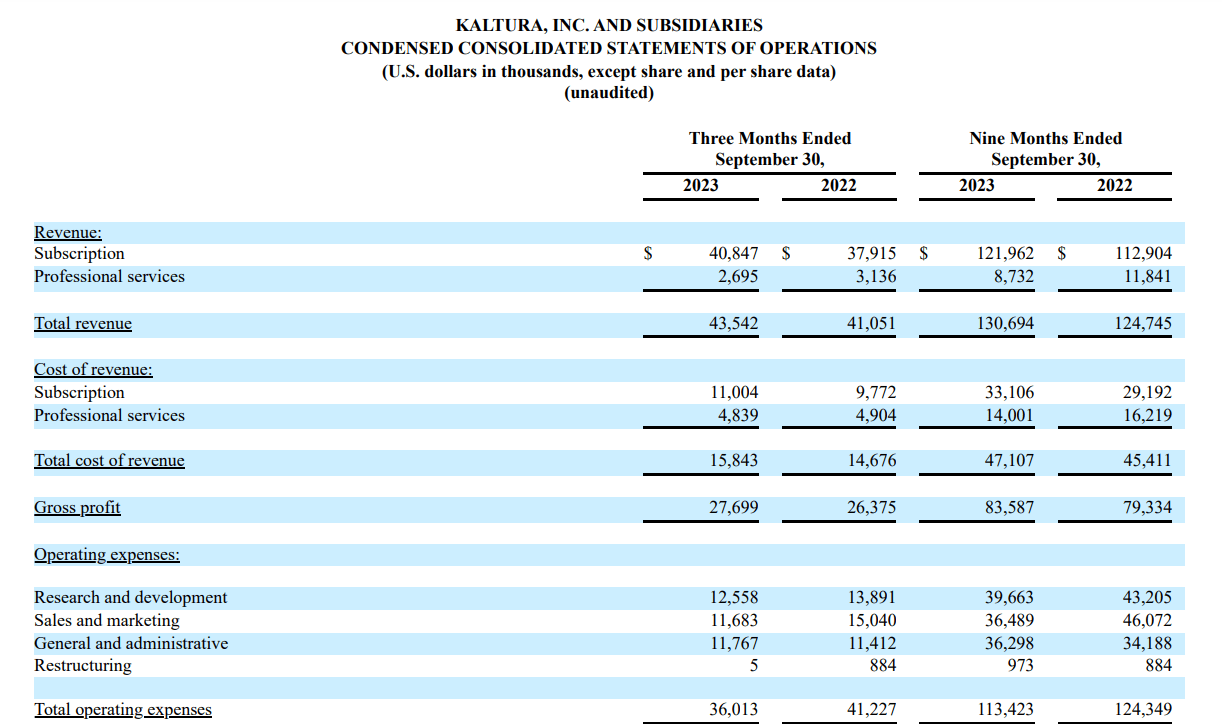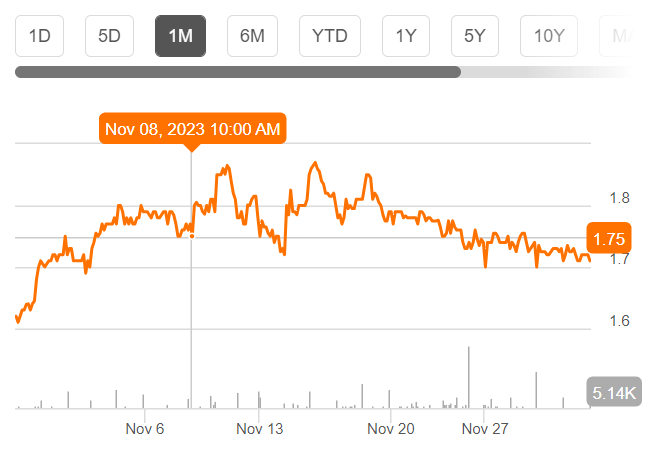Andrea Migliarini/iStock via Getty Images
When it comes to investing, knowing where NOT to put your money is often far more important than knowing where to put it. I say this from my own perspective as a risk-averse investor who not only looks for great investment opportunities to share with others; but, and more importantly, as one who looks for those unobtrusive sinkholes that are largely unprofitable for years on end and cash has been leaking like a sieve. One such company, I believe, is Kaltura (NASDAQ:KLTR), a cloud-based video services provider based out of New York City. I’m recommending a Sell rating for this stock, and the analysis below tells you why.
About the Company
Although Kaltura has only been publicly traded for less than three years (IPO was in July 2021), it’s been around for a lot longer – since 2006, in fact. Admittedly, Kaltura’s founders had a vision that was far advanced for their day. In the pre-iPhone era, when the word ‘cloud’ only made you look up at the sky, they were already envisioning a world where the video experience would be accessible to anyone without the need for expensive on-prem infrastructure and resources. In that respect, Kaltura was one of the pioneers of the SaaS video experience, having incorporated the company along those lines a mere year after the term itself was first coined.
The Problem of Unprofitability Vs. The Opportunity for Growth
Investors often get caught up in companies with apparent growth opportunities, but for the most part, unprofitability invariably catches up, rendering the growth meaningless because it’s left a long trail of burned cash and sunk costs. Of course, I recognize that much of this expounding comes from the benefit of hindsight, but the point I’m trying to make is that once you know that a business isn’t going anywhere soon (and, more to the point, hasn’t gone anywhere for so long), you shouldn’t be putting your money in no matter how positive the outlook.
Naturally, this does not include businesses that aren’t supposed to turn a quick profit, such as clinical-stage biotechs and other capital-intensive companies that rely mostly on a wing and a prayer to eventually make them profitable in some distant future. Such companies can certainly turn out to be exceedingly profitable, but the bulk of them are moonshots until they get their first drug approval. Even then, commercialization, insurance coverage, gaining market share from incumbents in the space, and other expensive line items often delay their profitability by several more years, if it ever comes.
SaaS companies, on the other hand, are more capital-intensive at the beginning when they’re just growing their user base, but the advantage of operating leverage means their costs grow increasingly slower as they scale up. Moreover, once they have a certain amount of sales momentum, they also have the advantage of the network effect and can start trimming their SG&A to reach profitability quickly. They can also continue to invest in maintenance and growth capex while keeping their cash flows well in the black – and growing.
Unfortunately, Kaltura has turned out to be one of the unlucky ones that, despite growing revenues at a steady clip, has remained unprofitable for the greater part of its existence as a publicly traded company.
Kaltura’s Revenue Growth, Operating Costs, And The Bottom Line
Seeking Alpha | Kaltura Revenue History (Annual)
Seeking Alpha | Kaltura Net Income History (Annual)
Since the December quarter of 2019 until the LTM period (as at Q3 2023), Kaltura’s revenues have grown at a CAGR of roughly 16%, while net losses have been growing at a CAGR of around 33%. That’s not what you want to see from a mature SaaS company that’s aggressively marketing its products worldwide. What you do want to see is some sort of cadence approaching breakeven, even if it’s taken this long and still has a ways to go.
Let’s break this down into a recent quarterly view to see if any positive trends are emergent.
Seeking Alpha | Net Losses from Q3 2022 to Q3 2023
It would appear that there’s some positive trending in play here, with net losses nearly halving over the past four quarters. The only problem is that when you look at operating cash flows, it’s clear that SBC is playing no small part in pushing the company toward cash-flow profitability. That line item has grown from about $6 million to about $7.5 million for a 25% YoY growth rate during the period under discussion. That’s not really where you want profitability to come from, although being cash flow positive is certainly not a bad thing.
Another positive is that operating expenses have dropped 10% from about $40 million to $36 million, which seems to be another key driver of profitability from a P&L standpoint. Meanwhile, however, quarterly revenues only grew 6% during that time, from $41 million to $43.5 million, demonstrating some amount of operating leverage. However, there’s more than meets the eye even here.
The real issue here is that revenue growth is slowing down, and the only reason we’re seeing that uptick at the bottom line is that costs are being cut aggressively and at a pace greater than the decline in revenue growth rates. This is not an ideal situation because what you want to see, as an investor, is stable to strong revenue growth and a large amount of operating leverage that wouldn’t demand cost-cutting in order for operating costs to be sustainable. This is not what you want to see, even in a relatively mature SaaS company. Ideally, you want that operating leverage to show up alongside revenue growth, and that’s not happening with Kaltura.
To summarize, on the one hand, there’s a clear lack of strong operating leverage here; on the other, the cost-cutting is likely impacting revenue growth because the company is increasingly spending less on SG&A. To me, that’s a red flag any way you look at it. The improvements in operating cash flows and bottom-line profitability (or declining losses) are not being driven by revenue growth and operating leverage but through sacrificing expenditure that’s sorely needed for growth, especially at a time when companies are taking long, hard looks at their budgets in anticipation of a tough year ahead.
Looking at the breakdown of the company’s operating expenses in Q3, it’s clear that they’re spending a lot less on sales and marketing than they did a year ago. That’s not what investors want to see, and what tends to make the camel’s back ache even more is that sales and marketing expenses are now even lower than G&A.
Company Filings – Q3
The Q3 earnings call contained clues to further slowdowns in growth over the holiday quarter. Per Yaron Garmazi, Kaltura’s CFO:
I would now like to turn to our outlook for the fourth quarter of 2023 and for the fiscal year ending December 31, 2023. In the fourth quarter, we expect subscription revenue to be between 3% decline to 1% growth to between $38.4 million and $39.8 million, and total revenue to decrease by 7% to 4% to between $40.8 million and $42.3 million.
Putting that together, we’re in a situation where sales and marketing expenses are being slashed ahead of a quarter where revenue growth is expected to go into negative territory. Definitely not what investors want to see, and it’s telling on the share price, which initially popped after a dual consensus beat but has since declined and shows no signs of recovery.
Seeking Alpha | KLTR 1M Price Chart
My biggest concern here is not that a poor upcoming quarter has already been priced in, but that things are likely to get worse if this trend of cutting costs eats further into their ability to market and sell their services. The network effect we spoke about earlier is completely absent, as is any sort of operating leverage you’d normally expect to see in a mature SaaS company.
My Recommendation
I wouldn’t normally recommend selling securities that you may have held for a long time, but I’m making an exception for a stock that’s trading at a greater than 50% discount to its peers, as you can see from the EV to forward sales multiple of 1.26 vs the sector’s 2.86. This is not a bargain deal even at this price. I see the price going even lower unless Kaltura can deliver a stellar Q4, but that doesn’t look like it’s on the cards because sales growth is not being preceded by growing marketing spend.
Of course, the upside risk here is that we see a rejuvenation of revenue growth in the next quarter’s earnings, along with improvements on the profitability front, but I think the probability of that happening is quite low.



